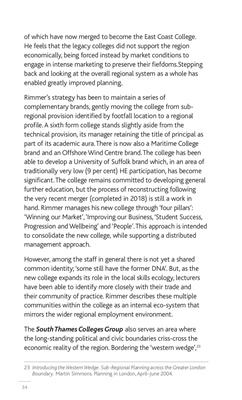
34
of which have now merged to become the East Coast College.
He feels that the legacy colleges did not support the region
economically, being forced instead by market conditions to
engage in intense marketing to preserve their fiefdoms.Stepping
back and looking at the overall regional system as a whole has
enabled greatly improved planning.
Rimmer's strategy has been to maintain a series of
complementary brands, gently moving the college from subregional
provision identified by footfall location to a regional
profile. A sixth form college stands slightly aside from the
technical provision, its manager retaining the title of principal as
part of its academic aura. There is now also a Maritime College
brand and an Offshore Wind Centre brand. The college has been
able to develop a University of Suffolk brand which, in an area of
traditionally very low (9 per cent) HE participation, has become
significant. The college remains committed to developing general
further education, but the process of reconstructing following
the very recent merger (completed in 2018) is still a work in
hand. Rimmer manages his new college through 'four pillars':
'Winning our Market', 'Improving our Business, 'Student Success,
Progression and Wellbeing' and 'People'. This approach is intended
to consolidate the new college, while supporting a distributed
management approach.
However, among the staff in general there is not yet a shared
common identity; 'some still have the former DNA'. But, as the
new college expands its role in the local skills ecology, lecturers
have been able to identify more closely with their trade and
their community of practice. Rimmer describes these multiple
communities within the college as an internal eco-system that
mirrors the wider regional employment environment.
The South Thames Colleges Group also serves an area where
the long-standing political and civic boundaries criss-cross the
economic reality of the region. Bordering the 'western wedge',23
23 Introducing the Western Wedge. Sub-Regional Planning across the Greater London
Boundary. Martin Simmons. Planning in London, April-June 2004.